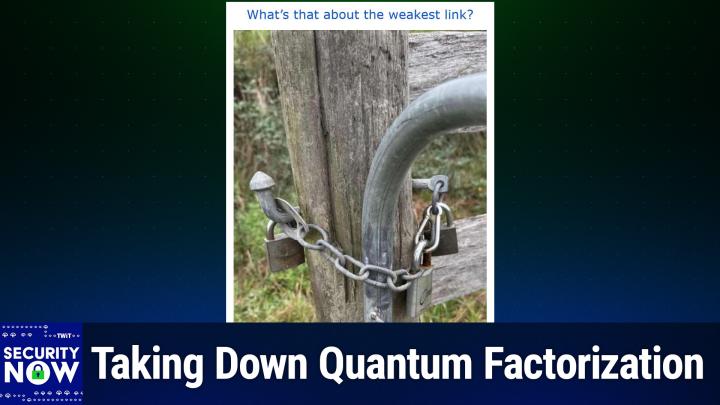The Great Quantum Computing Hoax
AI-created, human-edited.
In a bombshell revelation that has sent shockwaves through the tech community, renowned cryptographer Peter Gutmann has published a scathing academic paper that systematically debunks virtually every claimed quantum computing factorization "breakthrough" of the past two decades. The paper, with the provocative title "Replication of Quantum Factorization Records with an 8-Bit Home Computer, an Abacus and a Dog," delivers a devastating blow to the hype surrounding quantum computing's threat to modern cryptography.
During a recent episode of Security Now, hosts Leo Laporte and Steve Gibson discussed this groundbreaking paper with a mixture of vindication and frustration. Gibson, who has long been skeptical of quantum computing claims, expressed relief that his intuition about the field's lack of genuine progress was finally validated by serious academic research.
"I felt somewhat heartened to learn that my intuition here and my understanding of physics where it matters may be intact," Gibson noted, referring to his years of questioning whether quantum computers factoring small numbers like 15 and 21 represented genuine scalability toward breaking real-world cryptography.
Initially shocked by the revelations, Laporte admitted to feeling deceived: "I've been reporting it as if they're real. I mean, they pulled the wool over our eyes." This sentiment reflects the broader tech journalism community's uncritical acceptance of quantum computing press releases over the years.
Peter Gutmann, a computer scientist at the University of Auckland with extensive credentials in cryptography and security, methodically dismantles the quantum computing narrative. His paper reveals that virtually every celebrated quantum factorization achievement relied on what he terms "sleight of hand" techniques:
The most damning revelation concerns the numbers chosen for factorization. Rather than using randomly generated integers, researchers consistently selected specially constructed numbers that made factorization trivial:
- Binary Manipulation: Numbers like the 2019 factorization of 1,099,551,473,989 appear impressive in decimal but consist almost entirely of zeros when expressed in binary
- Adjacent Factors: The celebrated RSA 2048 factorization used factors that differed by only a few bits, making the problem solvable through simple square root calculations
- Repeating Patterns: Many "quantum factorizations" used numbers with obvious repeating bit patterns that any classical computer could easily exploit
Perhaps most shocking is the revelation that the famous factorizations of 15 and 21 used a "compiled form" of Shor's algorithm that required prior knowledge of the answer. As one analysis quoted in the paper states: "it is not legitimate for a compiler to know the answer to the problem being solved."
This technique reduced the quantum computing requirements from 8-10 qubits to just 2 qubits by essentially verifying known factors rather than discovering them—a process Gutmann and his colleagues describe as fundamentally fraudulent.
In a brilliant demonstration of the quantum computing field's failings, Gutmann's team replicated every significant quantum factorization record using:
- A 1981 Commodore VIC-20: The 8-bit home computer successfully factorized the same numbers celebrated in quantum computing papers
- An Abacus: Traditional calculating methods proved equally capable
- A Dog Named Scribble: The paper's most memorable achievement involved training a dog to bark three times, simultaneously "factorizing" both 15 and 21 (since both share the factor 3)
The ranking system established by the researchers places quantum computers at the bottom: "we rank a VIC-20 above an abacus, an abacus above a dog and a dog above a quantum factorization physics experiment."
The paper's findings have profound implications for cybersecurity policy and investment. For years, organizations have been pressured to prepare for "quantum-resistant" cryptography based on the assumption that quantum computers posed an imminent threat to current encryption standards.
Gibson's reaction captures the relief many security professionals feel: "We can all take a deep, slow breath and not worry that the factorizing problem is going to be solved anytime soon. It's all just been a scam."
The hosts speculated about the motivations behind these misleading claims. Laporte wondered whether even reputable organizations like IBM and Google were involved, suggesting that funding pressures might drive researchers to oversell their achievements.
Gibson noted that many papers seemed designed to generate "publication credit" rather than genuine scientific advancement, with researchers finding increasingly creative ways to transform factorization problems into forms solvable by current quantum hardware limitations.
Gutmann's paper exposes past deceptions and provides concrete criteria for evaluating future quantum computing claims. Section 7 establishes rigorous standards for selecting numbers that would constitute legitimate factorization achievements, essentially creating a framework to prevent future "stunt factorizations."
This revelation is a stark reminder of the importance of skeptical analysis in technology reporting. The quantum computing field's ability to maintain its narrative despite minimal genuine progress highlights how complex technical subjects can be misrepresented to the media and the public.
As Laporte reflected: "This is depressing... confirmation that we live in a very bad timeline where people are just corrupt." The comment underscores the frustration many feel when discovering that widely reported technological breakthroughs were fundamentally misleading.
Peter Gutmann's paper represents a watershed moment in quantum computing discourse. The paper forces a fundamental reevaluation of the field's claims and timeline by demonstrating that a decades-old home computer, basic calculating tools, and even a pet dog can match the factorization achievements of multi-million-dollar quantum research programs.
For cybersecurity professionals and technology enthusiasts who have long questioned the quantum computing hype, this research provides scientific validation of their skepticism. More importantly, it establishes clear standards for evaluating future claims, potentially preventing similar deceptions in the ongoing quantum computing research landscape.
The quantum computing revolution may still come someday, but based on this analysis, it remains far more distant than the breathless press releases have suggested. In the meantime, our current cryptographic systems can rest secure, protected not by quantum uncertainty but by the simple fact that even the most advanced "quantum" achievements to date can be replicated by barking three times.
Subscribe and never miss an episode! TWiT.tv/subscribe
Want ad-free Club TWiT exclusive podcasts? You can join Club TWiT for $10/month and get everything the club offers!
